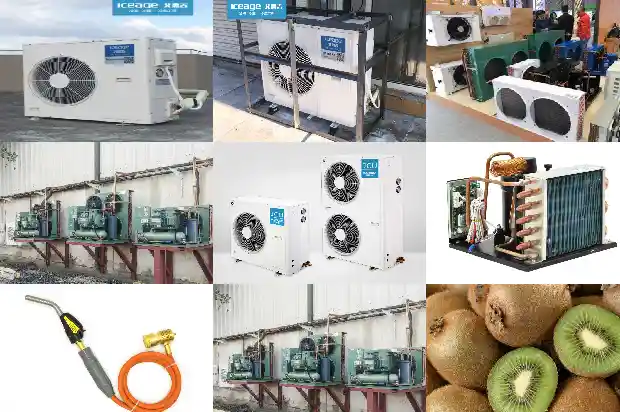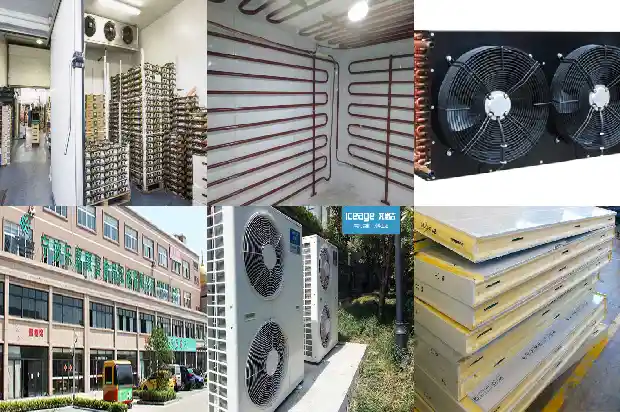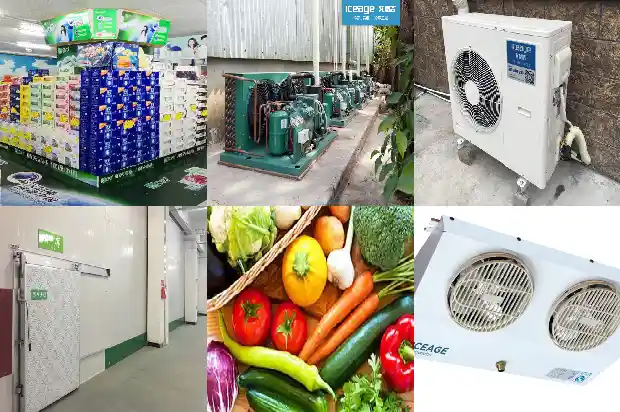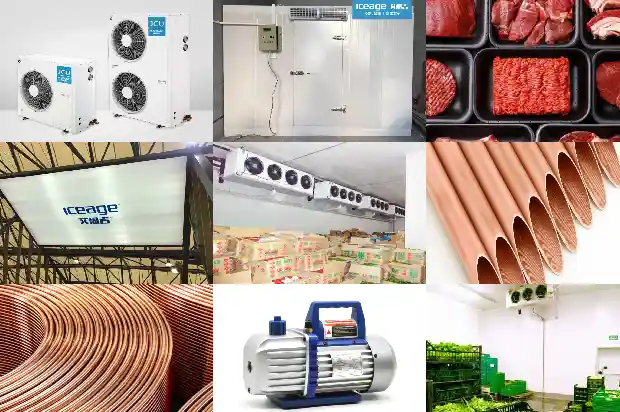Why Does the Compressor Always Trigger the Overheat Protection?
2025-02-28
Compressor overheat protection means that in order to protect the compressor motor from being burned out, when the motor temperature or the temperature of the compressor itself exceeds a certain value, some built-in or external protection devices are used to cut off the working power supply of the compressor, thus achieving the function of protecting the compressor.
After the refrigeration compressor sucks in the low-temperature and low-pressure gaseous refrigerant from the system, it directly enters the casing cavity of the compressor. The sucked refrigerant first cools the motor and then undergoes compression. Therefore, the degree of superheat of the sucked refrigerant vapor is an important reason for whether the compressor overheats.

The main reasons for the overheating of the exhaust temperature are as follows:
High return gas temperature, large motor heat generation, high compression ratio, high condensing pressure, and improper refrigerant selection.
(1) High return gas temperature
The high or low return gas temperature is relative to the evaporation temperature. In order to prevent liquid return, the return gas pipeline generally requires a return gas superheat of 20°C. If the insulation of the return gas pipeline is poor, the superheat will be far higher than 20°C.
The higher the return gas temperature, the higher the suction temperature and exhaust temperature of the cylinder.
For every 1°C increase in the return gas temperature, the exhaust temperature will increase by 1 to 1.3°C.
(2) Motor heating
For the return gas cooling type compressor, the refrigerant vapor is heated by the motor when flowing through the motor cavity, and the suction temperature of the cylinder is increased again. The heat generation of the motor is affected by its power and efficiency, and the power consumption is closely related to the displacement, volumetric efficiency, working conditions, frictional resistance, etc.
For the return gas cooling type semi-hermetic compressor, the temperature rise range of the refrigerant in the motor cavity is roughly between 15 and 45°C. In the air cooling (air-cooled) type compressor, the refrigerant does not pass through the winding, so there is no problem of motor heating.
(3) Too high compression ratio
The exhaust temperature is greatly affected by the compression ratio. The larger the compression ratio, the higher the exhaust temperature. Reducing the compression ratio can significantly reduce the exhaust temperature. Specific methods include increasing the suction pressure and reducing the exhaust pressure.
The suction pressure is determined by the evaporation pressure and the resistance of the suction pipeline. Increasing the evaporation temperature can effectively increase the suction pressure, quickly reduce the compression ratio, and thus reduce the exhaust temperature.
Some users one-sidedly believe that the lower the evaporation temperature, the faster the cooling speed. In fact, this idea has many problems. Although reducing the evaporation temperature can increase the refrigeration temperature difference, the refrigeration capacity of the compressor decreases, so the freezing speed is not necessarily faster. Moreover, the lower the evaporation temperature, the lower the refrigeration coefficient, while the load increases, the running time is extended, and the power consumption will increase.
Reducing the resistance of the return gas pipeline can also increase the return gas pressure. Specific methods include timely replacing the dirty and blocked return gas filter, minimizing the length of the evaporator pipe and the return gas pipeline as much as possible, etc. In addition, insufficient refrigerant is also a factor contributing to the low suction pressure. The refrigerant should be replenished in time after it leaks out. Practice shows that reducing the exhaust temperature by increasing the suction pressure is simpler and more effective than other methods.
The main reason for the too high exhaust pressure is the too high condensing pressure. Insufficient heat dissipation area of the condenser, fouling, insufficient cooling air volume or water volume, too high cooling water or air temperature, etc. can all lead to too high condensing pressure. It is very important to select an appropriate condensing area and maintain a sufficient flow rate of the cooling medium.
The designed operating compression ratio of high-temperature and air-conditioning compressors is relatively low. When used for freezing, the compression ratio is increased several times, the exhaust temperature is very high, and the cooling cannot keep up, resulting in overheating. The compressor should be avoided from being used beyond its range, and the compressor should be operated at the smallest possible compression ratio. In some low-temperature systems, overheating is the primary cause of compressor failures.
(4) Anti-expansion and gas mixing
After the suction stroke starts, the high-pressure gas remaining in the clearance of the cylinder will have an anti-expansion process. After the anti-expansion, the gas pressure returns to the suction pressure, and the energy consumed for compressing this part of the gas is lost during the anti-expansion. The smaller the clearance, on the one hand, the smaller the power consumption caused by the anti-expansion, and on the other hand, the larger the suction volume, so the energy efficiency ratio of the compressor is greatly increased.
During the anti-expansion process, the gas contacts and absorbs heat from the high-temperature surfaces of the valve plate, the top of the piston, and the top of the cylinder. Therefore, the gas temperature will not drop to the suction temperature at the end of the anti-expansion.
After the anti-expansion ends, the real suction process begins.
Anti-expansion is caused by the clearance of the cylinder and is a drawback that cannot be avoided for traditional piston compressors.
(5) Compression temperature rise and refrigerant types
The thermophysical properties of different refrigerants are different, and the amount of exhaust temperature rise after experiencing the same compression process is different. Therefore, for different refrigeration temperatures, different refrigerants should be selected.
High return gas temperature, large motor heat generation, high compression ratio, high condensing pressure, and improper refrigerant selection.
(1) High return gas temperature
The high or low return gas temperature is relative to the evaporation temperature. In order to prevent liquid return, the return gas pipeline generally requires a return gas superheat of 20°C. If the insulation of the return gas pipeline is poor, the superheat will be far higher than 20°C.
The higher the return gas temperature, the higher the suction temperature and exhaust temperature of the cylinder.
For every 1°C increase in the return gas temperature, the exhaust temperature will increase by 1 to 1.3°C.
(2) Motor heating
For the return gas cooling type compressor, the refrigerant vapor is heated by the motor when flowing through the motor cavity, and the suction temperature of the cylinder is increased again. The heat generation of the motor is affected by its power and efficiency, and the power consumption is closely related to the displacement, volumetric efficiency, working conditions, frictional resistance, etc.
For the return gas cooling type semi-hermetic compressor, the temperature rise range of the refrigerant in the motor cavity is roughly between 15 and 45°C. In the air cooling (air-cooled) type compressor, the refrigerant does not pass through the winding, so there is no problem of motor heating.
(3) Too high compression ratio
The exhaust temperature is greatly affected by the compression ratio. The larger the compression ratio, the higher the exhaust temperature. Reducing the compression ratio can significantly reduce the exhaust temperature. Specific methods include increasing the suction pressure and reducing the exhaust pressure.
The suction pressure is determined by the evaporation pressure and the resistance of the suction pipeline. Increasing the evaporation temperature can effectively increase the suction pressure, quickly reduce the compression ratio, and thus reduce the exhaust temperature.
Some users one-sidedly believe that the lower the evaporation temperature, the faster the cooling speed. In fact, this idea has many problems. Although reducing the evaporation temperature can increase the refrigeration temperature difference, the refrigeration capacity of the compressor decreases, so the freezing speed is not necessarily faster. Moreover, the lower the evaporation temperature, the lower the refrigeration coefficient, while the load increases, the running time is extended, and the power consumption will increase.
Reducing the resistance of the return gas pipeline can also increase the return gas pressure. Specific methods include timely replacing the dirty and blocked return gas filter, minimizing the length of the evaporator pipe and the return gas pipeline as much as possible, etc. In addition, insufficient refrigerant is also a factor contributing to the low suction pressure. The refrigerant should be replenished in time after it leaks out. Practice shows that reducing the exhaust temperature by increasing the suction pressure is simpler and more effective than other methods.
The main reason for the too high exhaust pressure is the too high condensing pressure. Insufficient heat dissipation area of the condenser, fouling, insufficient cooling air volume or water volume, too high cooling water or air temperature, etc. can all lead to too high condensing pressure. It is very important to select an appropriate condensing area and maintain a sufficient flow rate of the cooling medium.
The designed operating compression ratio of high-temperature and air-conditioning compressors is relatively low. When used for freezing, the compression ratio is increased several times, the exhaust temperature is very high, and the cooling cannot keep up, resulting in overheating. The compressor should be avoided from being used beyond its range, and the compressor should be operated at the smallest possible compression ratio. In some low-temperature systems, overheating is the primary cause of compressor failures.

(4) Anti-expansion and gas mixing
After the suction stroke starts, the high-pressure gas remaining in the clearance of the cylinder will have an anti-expansion process. After the anti-expansion, the gas pressure returns to the suction pressure, and the energy consumed for compressing this part of the gas is lost during the anti-expansion. The smaller the clearance, on the one hand, the smaller the power consumption caused by the anti-expansion, and on the other hand, the larger the suction volume, so the energy efficiency ratio of the compressor is greatly increased.
During the anti-expansion process, the gas contacts and absorbs heat from the high-temperature surfaces of the valve plate, the top of the piston, and the top of the cylinder. Therefore, the gas temperature will not drop to the suction temperature at the end of the anti-expansion.
After the anti-expansion ends, the real suction process begins.

Anti-expansion is caused by the clearance of the cylinder and is a drawback that cannot be avoided for traditional piston compressors.

(5) Compression temperature rise and refrigerant types
The thermophysical properties of different refrigerants are different, and the amount of exhaust temperature rise after experiencing the same compression process is different. Therefore, for different refrigeration temperatures, different refrigerants should be selected.
Conclusions and suggestions
The compressor should not have overheating phenomena such as high motor temperature and too high exhaust temperature during normal operation within the service range. Compressor overheating is an important fault signal, indicating that there are serious problems in the refrigeration system, or the use and maintenance of the compressor are improper.
If the root cause of the compressor overheating lies in the refrigeration system, the problem can only be solved by improving the design and maintenance of the refrigeration system. Replacing a new compressor cannot fundamentally eliminate the overheating problem.
The compressor should not have overheating phenomena such as high motor temperature and too high exhaust temperature during normal operation within the service range. Compressor overheating is an important fault signal, indicating that there are serious problems in the refrigeration system, or the use and maintenance of the compressor are improper.
If the root cause of the compressor overheating lies in the refrigeration system, the problem can only be solved by improving the design and maintenance of the refrigeration system. Replacing a new compressor cannot fundamentally eliminate the overheating problem.
Related Articles
- Reasons for Compressor Oil Deterioration and Oil - adding Operations
- Screw Compressor Units: Principles, Design and Selection - Essential Guide for Refrigeration Beginners
- Analysis of Causes for Compressor Liquid Hammer, Overheating and Pre - heating
- Oil Cooling Methods and Oil - changing Operation Procedures for Screw Compressors
- Have You Encountered the Three Common Problems of Refrigeration Compressors?
- What to Do if the Compressor of a Frozen and Refrigerated Display Cabinet Runs but the Refrigeration Effect Is Poor?
- What to Do if the Compressor of the 【Refrigerated and Frozen Display Cabinet】 Unit Fails to Start?
- Precautions for Using Rotary Refrigeration Compressors
- How to Resolve the Scuffing Issue of Cold Storage Compressors
- Composition and Common Faults of Screw Refrigeration Compressors
- What Are the Causes of Scroll Compressor Damage?
- Do You Know These Four Scenarios That Can Cause Compressor Failures?
- What Are the Reasons for Insufficient Air Output of Screw Air Compressors?
- How to Solve the Problem of Frequent Shutdown and Startup of Cold Storage Compressors?
- How to Schedule Overhauls, Medium - sized and Minor Repairs of Screw Refrigeration Compressors?
- Why Can't Compressors Start Directly? What Are the Advantages of Soft Starters?
- Maintenance Methods for Faults in Screw Refrigeration Air - conditioner Compressors
- Solutions to Common Compressor Failures
